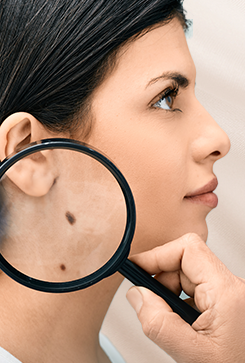
Our skin is the largest organ of our body. It is exposed to many negative effects throughout our lives. Today, skin cancer is the most common type of cancer.
The incidence of skin cancers is rapidly increasing due to the thinning of the ozone layer, the acceptance of bronze skin as more beautiful, solarium applications, and the proliferation of chemical carcinogens. All of these factors cause DNA damage to cells in the outermost skin layers. Damaged cells are mostly eliminated by the body's defense mechanisms. In some cases, these cells turn out of control and become skin cancer.

There are basically 3 types of skin cancer:
It is the most common and benign type. It does not usually metastasize to other areas. However, if it is neglected, it will invade the region and grow. The best treatment is to have BCC removed when it is minimal. If neglected and grown, treatment will be difficult. It should be excised with a circumscription of at least 0.5 cm.
The clinical prognosis of each subtype, hence its treatment, is different.
It occurs less frequently. However, there is a risk of metastasis. Depending on the size and type, regional lymph nodes may also need to be removed. In principle, it should be excised with a circumscription of at least 1 cm. This type of skin cancer usually occurs in areas of chronic trauma, burns, and non-healing wounds. The SCC type developing at those sites is called Marjolin’s ulcer. Marjolin ulcers are aggressive, treatment is difficult, and the recurrence rate is high.
The most aggressive and dangerous form of skin cancer. It may arise in present moles in the skin or may develop without any precursor lesions.
In early recognition, it can be treated successfully. Depending on the type and depth spread, treatment of regional lymph nodes may be necessary. Follow-up is also required after surgery.
Types:
There are many criteria that determine the treatment and prognosis of malignant melanoma. The most important criterion is the depth of the melanoma (radial growth, Breslow depth). The surgical treatment method is determined according to the depth and other criteria and biopsy results.
Also, many other types of skin cancer are less common.
It is necessary to consult a doctor when new swellings, pigmented or unusual-looking growths, redness, scallops, peeling, and itching occur in the skin. Besides, in cases of wounds that do not heal in 2 weeks despite treatment, exacerbation, and smell of chronic wounds, a plastic surgeon should be consulted.
Biopsy is applied for the lesions required. If it is diagnosed as “skin cancer” after a biopsy, its treatment will be planned according to its type and subtype.
The most important symptom of skin cancer is a new mole or change in its size, shape, or color. If this spot looks different from others on your skin, it may be a sign of skin cancer. This is also called “the ugly duckling sign.” If you observe any of these warning signs, you should see your doctor immediately.
It is difficult to distinguish between a normal mole and melanoma. Therefore, it is best to consult a specialist physician as soon as possible
The treatment of skin cancer is intended to remove all of the cancerous tissue without leaving any residue. Today, there is a high rate of success in skin cancer with surgical procedures. With the removal of cancerous tissue at sufficient depth and width, recurrence is prevented as well.
In addition to the removal of cancerous tissue, it is also important that there is no aesthetic scar and no loss of function.
To plan the surgery, it is necessary to diagnose the type of skin cancer first. For this purpose, a small biopsy is performed first.
According to the biopsy, the lesion is removed at the required distance and depth from the surrounding healthy tissue. A frozen section can be performed during surgery to avoid remnant cancer cells. When no cancer cell is left behind, the filling of the wound is the next stage.
If the wound is small, closure is performed with simple stitches. Meanwhile, deep tissues are sewn together and blind stitches are performed to obtain the most appropriate aesthetic result.
There are two options if the wound is larger:
Depending on the type of skin cancer, regional lymph nodes (groin, armpits, or neck) may also need to be removed.
It is a procedure performed to determine if there is an early-stage spread to the regional lymph node in some malignant melanoma and SCC types. Radioactive material (Tc 99) is injected into cancer tissue preoperatively. In surgery, the first lymph node (sentinel lymph node) is located with this gamma probe. This lymph node is removed and examined by pathology. If there is cancer spread to the sentinel lymph node, it is necessary to remove all regional lymph nodes.
Skin cancer is not an infectious disease.
Address: Fulya Mah. Büyükdere Cad No:74 Torun Center Flat Office 207 Şişli /İstanbul
Contact Us
+90 (505) 973 48 73